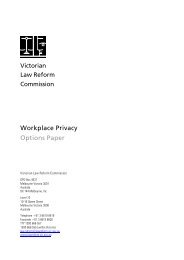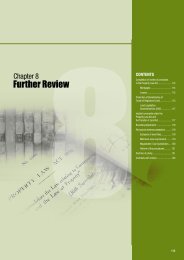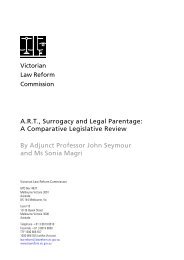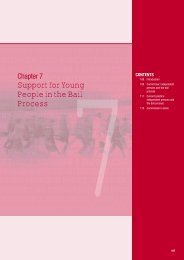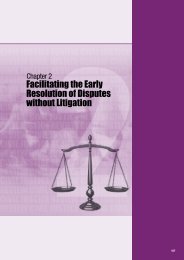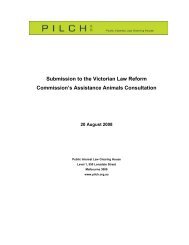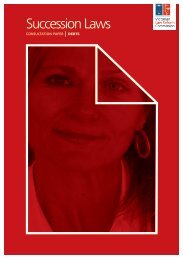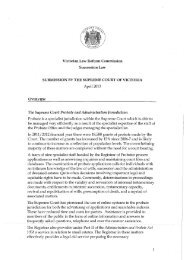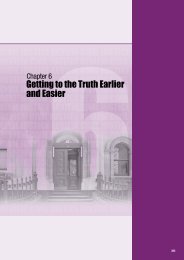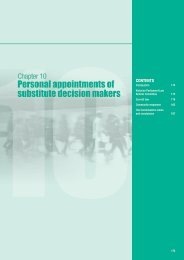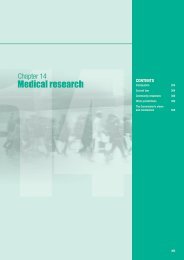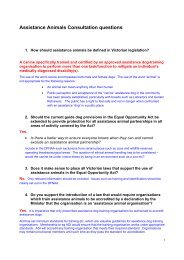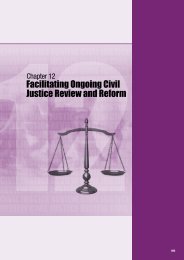Succession Laws - Victorian Law Reform Commission
Succession Laws - Victorian Law Reform Commission
Succession Laws - Victorian Law Reform Commission
You also want an ePaper? Increase the reach of your titles
YUMPU automatically turns print PDFs into web optimized ePapers that Google loves.
<strong>Victorian</strong> <strong>Law</strong> <strong>Reform</strong> <strong>Commission</strong><strong>Succession</strong> <strong><strong>Law</strong>s</strong>: Consultation Paper I WillsThe ademption ruleCurrent law—the identity approach4.6 In Victoria, ademption is part of the common law—the Wills Act 1997 (Vic) does not itselfdeal with ademption.4.7 The law distinguishes between specific and general gifts when interpreting the provisionsof a will. A specific gift is of some property that is owned by the will-maker and isdescribed in a way that separates it from other assets, for example ‘my car’. A generalgift is of something which the will-maker directs shall be procured by the executor or thevalue of which shall be paid out of the estate by the executor. 44.8 Ademption applies only to specific gifts. When determining whether ademption hasoccurred, the court asks two questions:• is the gift specific (rather than general)?• if it is a specific gift, is the gifted property in the estate?4.9 If the gifted property is not in the estate, the gift fails. The beneficiary receives nothingand cannot receive the cash equivalent of the gifted property. 54.10 This rule is clear and easy to apply and avoids a case-by-case determination of the willmaker’sintent. 6 It is based on the assumption that, if a specific gift is no longer in theestate, the will-maker intended that the beneficiary would receive nothing in its place. 7If the will-maker did not intend this, they could have amended their will after the itemwas disposed of. 84.11 The rule as it applies in Victoria is sometimes described as reflecting the ‘identityapproach’ because, unless the specific gift as described in the will contemplates propertythat can be identified in the estate, the gift fails.The effect of the identity approach to ademption4.12 Although it produces a level of certainty, the identity approach to ademption is inherentlyinflexible and thus is capable of producing unjust results.4.13 Ademption may operate harshly and contrary to the likely intentions of the will-maker. 9The law assumes that a will-maker would intend a gift of specific property to fail if theproperty is no longer owned by them. However, in many cases, the will-maker may simplynot have thought about what they would like to happen in this event. 10464 Re Plowright [1971] VR 128.5 Ashburner v MacGuire [1786] 2 BRO. C. C. 62, 63; Rosalind Croucher and Prue Vines, <strong>Succession</strong>: Families, Property and Death: Text andCases (LexisNexis Butterworths, 3rd ed, 2009) 470.6 Alberta <strong>Law</strong> <strong>Reform</strong> Institute, Wills and the Legal Effect of Changed Circumstances, Final Report No 98 (2010) 151; Christina Walsh, ‘ACostly Application of Strict Statutory Construction: The Ohio Supreme Court’s Interpretation of Ohio’s Nonademption Statute’ (1996–7)28 University of Toledo <strong>Law</strong> Review 631, 631; David Onega, ‘Hegel’s Hobbled Heritage: The Ohio Supreme Court’s Use of the Doctrine ofAdemption to Prey on the Incompetent’ (1997) 26 Capital University <strong>Law</strong> Review 201, 206.7 Christina Walsh, ‘A Costly Application of Strict Statutory Construction: The Ohio Supreme Court’s Interpretation of Ohio’s NonademptionStatute’ (1996–7) 28 University of Toledo <strong>Law</strong> Review 631, 634.8 David Onega, ‘Hegel’s Hobbled Heritage: The Ohio Supreme Court’s Use of the Doctrine of Ademption to Prey on the Incompetent’ (1997)26 Capital University <strong>Law</strong> Review 201, 206.9 Note, ‘Ademption and the Testator’s Intent’ (1961) 74 Harvard <strong>Law</strong> Review 741, 746; Alberta <strong>Law</strong> <strong>Reform</strong> Institute, Wills and the Legal Effectof Changed Circumstances, Final Report No 98 (2010) 151; Walsh, above n 7, 631; United States Uniform Probate Code (2006) comment on§ 2-606; Mary Lundwall, ‘The Case Against the Ademption by Extinction Rule: A Proposal for <strong>Reform</strong>’ (1993–94) 29 Gonzaga <strong>Law</strong> Review105, 108; Re Morton [1963] VR 40, 53–4.10 Mary Lundwall, ‘The Case Against the Ademption by Extinction Rule: A Proposal for <strong>Reform</strong>’ (1993–94) 29 Gonzaga <strong>Law</strong> Review 105, 126.



